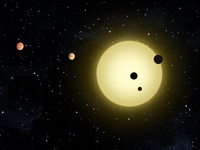MOFFET FIELD, CALIFORNIA—NASA's Kepler space telescope appears to have confirmed the existence of an alien world smaller than our own Earth—the first time such a planet has been discovered around a star like our sun. However, scientists are reluctant to provide any details about the find—announced on Tuesday at the First Kepler Science Conference here at NASA's Ames Research Center—before their work is published, probably early next year.
Despite its size, the new world—provisionally dubbed KOI-70.04—is very unlike our home planet. It orbits its star, a sun similar to our own known as Kepler-20, at a distance of just 9.6 million kilometers, completing one circuit every 6.1 days. Surface temperatures probably soar to almost 600°C, so there's no hope of finding liquid water there, let alone life.
Just like Earth, KOI-70.04 is part of a multiplanet system. Four other, larger planets orbit the same star—one even closer in, and three farther away. All five planets are closer to their star than Mercury is to the sun. In that respect, the planetary system resembles Kepler-11, an extremely compact system of six planets announced in February.
The Kepler telescope, launched in March 2009, scrutinizes over 150,000 stars for tiny periodic dips in brightness that might mean orbiting planets are passing in front of the stars, blocking part of their light from reaching the telescope. But other observations need to confirm the true planetary nature of these candidate events, because the observed dips may also be due to an eclipsing binary star in the background whose light blends with the foreground star studied by Kepler. An eclipse within the background binary would mimic a small brightness dip in Kepler-20.
The best way to confirm a candidate planet is by measuring the small, periodic wobbles it induces in its parent star. If that doesn't work, astronomers have a couple of other tricks up their sleeves to validate the planet.
Kepler project scientist Nick Gautier of NASA's Jet Propulsion Laboratory presented new data at the meeting on three of the larger planets in the Kepler-20 system, now officially known as Kepler-20b, -20c and -20d. From the star's wobbles, observed with ground-based telescopes, Gautier and his colleagues were able to deduce the masses of Kepler-20b and -20c: 8.7 and 16.1 Earth masses, respectively. Kepler-20d, the outermost planet in the system, was found to weigh in at less than 20.1 Earth masses. The three planets are between 1.9 and 3 times the size of Earth.
So what about the other two? "I can't disclose any details yet," says François Fressin of the Harvard Smithsonian Center for Astrophysics in Cambridge, Massachusetts, who has a paper about the two smaller planets in press with Nature, "but if they are also validated, and if their size estimates are right, KOI-70.04 is significantly smaller than the Earth." KOI-70.04 was already in Kepler's list of candidate planets back in February, together with the three Kepler-20 planets described by Gautier; KOI-70.05 was found in June.
Fressin won't confirm whether the two planets have indeed been validated, but if they weren't, they probably wouldn't warrant a Nature publication. Moreover, according to theoretical astrophysicist Jack Lissauer of NASA's Ames Research Center, "most Kepler multicandidates must be real planets." The reason is simple statistics: It's extremely unlikely to encounter two background eclipsing binaries (or one background binary and one genuine planet) at the same location.
Indeed, asked about Kepler-20, Daniel Fabrycky of the University of California, Santa Cruz, confirmed that it is the first genuine five-planet system found by the space telescope. But while Fressin agrees that Lissauer's statistical argument is strong, he says validation of a candidate planet, especially one as small as KOI-70.04 appears to be, is of paramount importance. "I can't tell you anything more at this moment," he says.
From the data published in February and the new estimates for the properties of the parent star presented by Gautier, it would follow that KOI-70.04 is between 80% and 90% of the size of Earth. For KOI-70.05, no data have been released yet, except its orbital period, which, according to Gautier, is 19.6 days. In Fressin's upcoming Nature paper, the two planets will almost certainly be renamed Kepler-20e and Kepler-20f.
Earlier this week, Kepler scientists announced the discovery of Kepler-22b, a relatively large planet (2.4 Earth diameters) in the habitable zone of its parent star, where temperatures allow the existence of liquid water. With Kepler-20e, they have bagged a real Earth-sized planet, albeit much too close to its star to harbor life. It probably won't be too long before the planet hunters hit upon their Holy Grail: a planet just like Earth in the habitable zone of a sunlike star. Stay tuned.

)
)
)


)
)
)
)
)
)
)
)